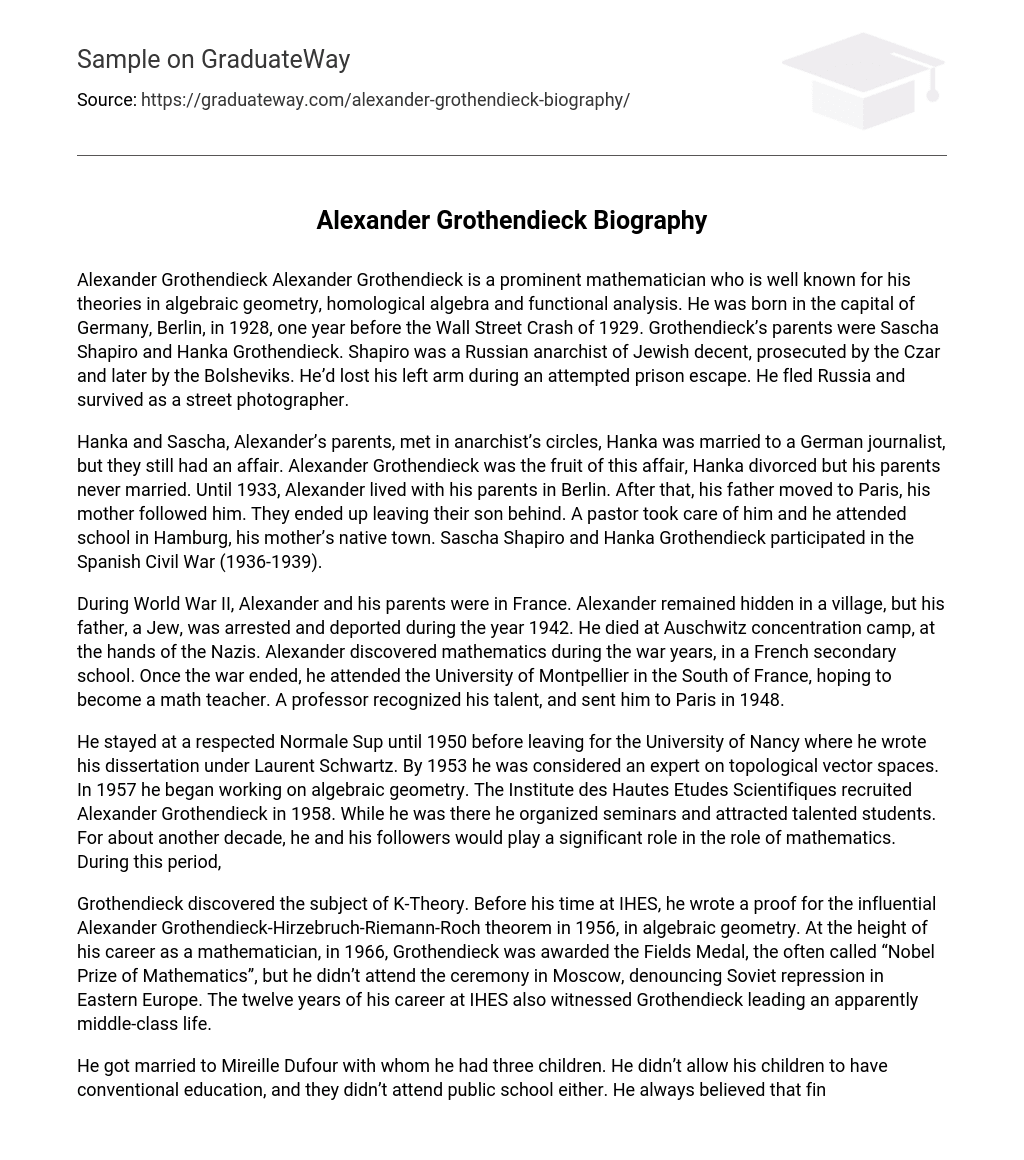Alexander Grothendieck Alexander Grothendieck is a prominent mathematician who is well known for his theories in algebraic geometry, homological algebra and functional analysis. He was born in the capital of Germany, Berlin, in 1928, one year before the Wall Street Crash of 1929. Grothendieck’s parents were Sascha Shapiro and Hanka Grothendieck. Shapiro was a Russian anarchist of Jewish decent, prosecuted by the Czar and later by the Bolsheviks. He’d lost his left arm during an attempted prison escape. He fled Russia and survived as a street photographer.
Hanka and Sascha, Alexander’s parents, met in anarchist’s circles, Hanka was married to a German journalist, but they still had an affair. Alexander Grothendieck was the fruit of this affair, Hanka divorced but his parents never married. Until 1933, Alexander lived with his parents in Berlin. After that, his father moved to Paris, his mother followed him. They ended up leaving their son behind. A pastor took care of him and he attended school in Hamburg, his mother’s native town. Sascha Shapiro and Hanka Grothendieck participated in the Spanish Civil War (1936-1939).
During World War II, Alexander and his parents were in France. Alexander remained hidden in a village, but his father, a Jew, was arrested and deported during the year 1942. He died at Auschwitz concentration camp, at the hands of the Nazis. Alexander discovered mathematics during the war years, in a French secondary school. Once the war ended, he attended the University of Montpellier in the South of France, hoping to become a math teacher. A professor recognized his talent, and sent him to Paris in 1948.
He stayed at a respected Normale Sup until 1950 before leaving for the University of Nancy where he wrote his dissertation under Laurent Schwartz. By 1953 he was considered an expert on topological vector spaces. In 1957 he began working on algebraic geometry. The Institute des Hautes Etudes Scientifiques recruited Alexander Grothendieck in 1958. While he was there he organized seminars and attracted talented students. For about another decade, he and his followers would play a significant role in the role of mathematics. During this period,
Grothendieck discovered the subject of K-Theory. Before his time at IHES, he wrote a proof for the influential Alexander Grothendieck-Hirzebruch-Riemann-Roch theorem in 1956, in algebraic geometry. At the height of his career as a mathematician, in 1966, Grothendieck was awarded the Fields Medal, the often called “Nobel Prize of Mathematics”, but he didn’t attend the ceremony in Moscow, denouncing Soviet repression in Eastern Europe. The twelve years of his career at IHES also witnessed Grothendieck leading an apparently middle-class life.
He got married to Mireille Dufour with whom he had three children. He didn’t allow his children to have conventional education, and they didn’t attend public school either. He always believed that finding one’s own way is more important than attending school. French mathematician Alexander Grothendieck developed the branch of category theory now called Grothendieck topologies, and conducted research in algebraic geometry, including the introduction of etale cohomolgy and proof of the Weil conjectures.
His work unified complex analysis, geometry, number theory, and topology, and spanned a breathtaking spectrum of mathematics, including the cohomological interpretation of L-functions, crystalline cohomolgy, derived categories, formalisms for local and global duality (the ‘six operations’), functional analysis, geometric objects through representable functions, sheaf cohomolgy as derived functions, and the ‘yoga of weights’. Grothendieck also travelled extensively over Eastern Europe, delivering more lectures at the School of Mathematics in Bucharest.
As a person, he was a pacifist with plenty of ideals and goals and was passionately against the nuclear-missile build-up of Soviets; this was the key reason why he refused to visit Moscow to receive his Fields Medal. In the 1960’s, the Vietnam War was well under way. Grothendieck was an anti-war activist and went as far as giving lectures in Vietnam in the middle of bombings. In 1970, he discovered the institute he worked for had accepted a military funding.
He decided to quit and step down from his position at IHES. Grothendieck was upset over the links between the military and the scientific community, as a form of protest he announced his retirement. A few years after this announcement, he returned to teaching, this time as a professor at the University of Montpellier. By 1988 he was officially retired. In the early 1970’s, Grothendieck began working less on mathematics and more on political causes including environmentalism and nuclear disarmament.
He spent several years living in an isolated commune, then converted to Buddhism, then embraced a mystic form of Christianity, then followed extreme Catholic teachings that had him surviving solely on the bread and wine of the Holy Communion. In the late 1980’s he went on an extended fast that nearly killed him, supposedly in an effort to force God to reveal Himself. In the 1980’s, Alexander became an open critic of the mathematical community. He published a lengthy manuscript titled “Recoltes et semailles” in 1986.
The Crafoord Prize was awarded to him in 1988, but he declined it. Criticism followed and was forwarded to journalists. In order to mark his 60th birthday, a collection of research papers- The Grothendieck Festschrift- was assembled and published in 1990. In 1991, Grothendieck withdrew to a mountain village in the Pyrenees in a secret location and has been living there ever since. The reclusive mathematician is still alive and well, and is 81 years old.





